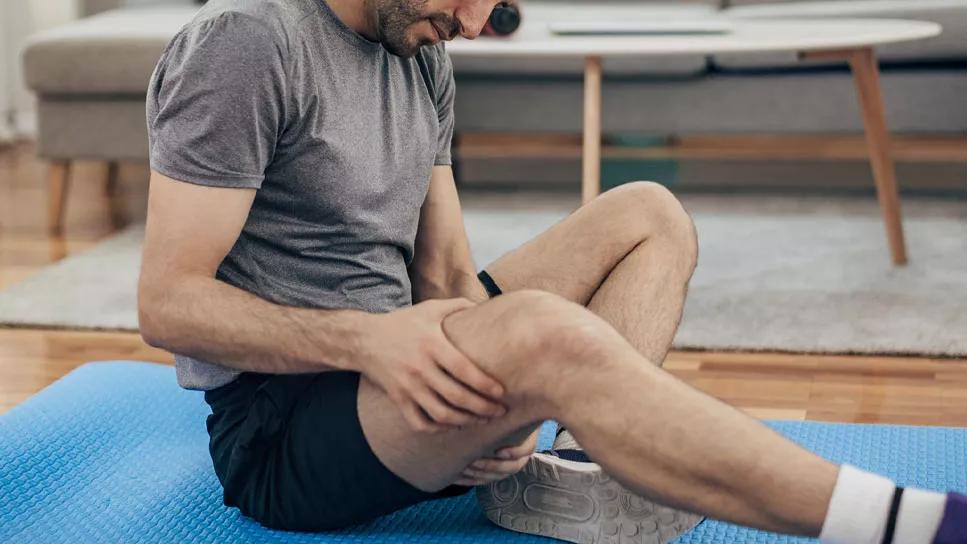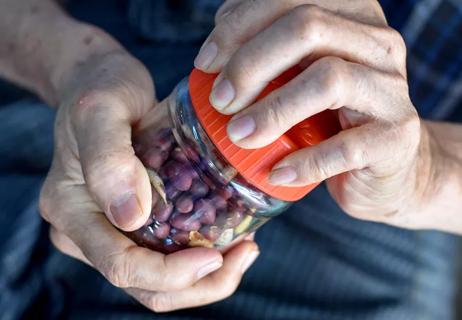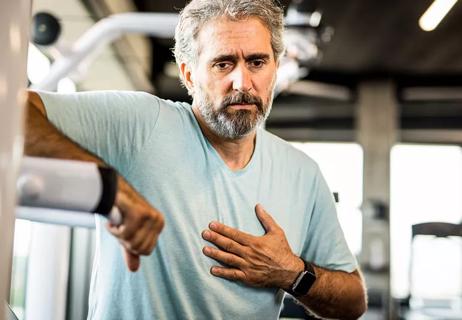Stretching, heating pads and massage guns can provide quick relief

It doesn’t matter how you position yourself or what you do. That little knob is always there, just underneath the surface of your skin, aching, throbbing and pricking you with pain. If you’re tired of feeling stiff and wondering if you should push through it or take it easy and relax those muscles until you’re fully healed, you’re not alone. Muscle knots are no joke.
Advertisement
Cleveland Clinic is a non-profit academic medical center. Advertising on our site helps support our mission. We do not endorse non-Cleveland Clinic products or services. Policy
Sports medicine specialist Michael Dakkak, DO, explains what causes muscle knots and what you should and shouldn’t do when they pop up unexpectedly.
The medical term for a muscle knot is a myofascial trigger point. You can think of them as small, tightly clenched muscle fibers underneath the surface of your skin. They can pop up anywhere, but they tend to happen more commonly around your:
“We tend to put a lot of stress and strain on these areas daily, especially if we’re sitting at our desks for a majority of the day,” says Dr. Dakkak. “But even if you’re on your feet, if you don’t have good posture or if you’ve experienced an injury, these things can certainly affect different areas along your back and upper neck.”
“A lot of times, you don’t visibly notice it,” says Dr. Dakkak. “In some cases, you can see some minor raising of the skin, but that’s not usual. In those cases, it’s more likely to be something else like a cyst or a tumor and it’s something that should be evaluated by a healthcare provider.”
Muscle knots can feel different depending on where they occur and what causes them, but they can feel aching, throbbing, tight or stiff. You might also feel small bumps or knots in your muscle that cause pain when you touch them, rub them or press on them. Your muscles may be tender or sore in general and consistently sore over time. Or you may experience weakness in your muscles and a reduced range of motion.
Advertisement
“It sometimes feels like a small pea or nodule or tissue underneath the skin,” explains Dr. Dakkak. “It can be bigger or smaller, but it’s usually painful when we’re directly pushing on the area and that’s what confirms our clinical diagnosis — point tenderness over a certain part of the muscle that has a nodule-like structure to it.”
Muscle knots happen because of over-exertion, stress or tension that’s placed on the affected area over extended periods of time. These muscle knots can develop whether you’re less physically active and sit for longer periods of the day or you exercise five days a week.
“If you’re in a seated position for a large amount of the day, that certainly causes an imbalance in your circulation and through that tightening of your muscles, it can cause these small nodules to form underneath your skin,” notes Dr. Dakkak. “On the opposite end of the spectrum, if someone is overusing their muscles, they can experience that same tightening of the muscles if they don’t allow enough time to stretch or heal between exercises.”
Getting rid of muscle knots is two-fold: You want to take preventive measures and know how to handle them without causing further injury when they inevitably surface.
Hydration is key to muscle movement. It not only helps with post-workout recovery, but it also helps keep your muscles fluid and helps ensure your blood flows faster to the areas it needs to get to, making for a faster recovery process.
“Hydration often gets overlooked,” says Dr. Dakkak.
Focusing on the four fundamentals of ergonomics — supporting your head, arms and back, and making time for movement — is key to avoiding muscle tension, stiffness and soreness that comes with muscle knots.
“You want a headrest, a raised keyboard, your screen at eye level — those are all very important — but then, you also want to take breaks sporadically throughout the day and walk around and work on your posture,” says Dr. Dakkak.
Taking the time for quick bursts of exercise, small walks or correcting your posture can make a world of difference if you’re trying to prevent muscle knots or strengthen the affected areas that are bothering you.
On the other end of the spectrum, if you over-exert yourself, stretching can help loosen you up if you feel stiff or tight in certain areas.
“Stretching overall is something that’s very helpful in these situations where you’re straining your muscles or being overactive and you’re experiencing the contraction of muscle fibers or that tightness in certain areas,” says Dr. Dakkak.
Advertisement
“Anything that’s aggravating you — sitting or sleeping positions, physical activities — it’s OK to avoid them or change your routine until you’re feeling better,” assures Dr. Dakkak. “If you’re able to work through different ranges of motion and stretches, that’s usually helpful, but if there’s a certain position that’s aggravating your symptoms, then we wouldn’t recommend that.”
A heating pad, hot tub, hot bath or sauna could provide some much-needed relief during painful flare-ups or times of stiffness.
“Heat tends to dilate your blood vessels so you have more blood flow to the region,” explains Dr. Dakkak. “More blood flow means more oxygen and more nutrients which helps trigger the healing response. If you have a constricted area, as we bring more blood flow to the area, those muscles will relax, too.”
Softly working the affected areas with your hands can be incredibly beneficial for reducing muscle knots. A specific kind of massage therapy called myofascial release therapy relies on constant, deep, gentle pressure to help release the tension and break up some of those constricted tissues in localized areas. Kneading smaller areas, like your neck, with a trigger point massage can also benefit small muscle knots, while massage rollers can be used as tools to help that process along in wider areas.
Advertisement
Dr. Dakkak says massage guns, though expensive, offer a wider range of benefits with different kinds of attachments designed to target specific areas of your body for deep tissue relief and muscle recovery.
“I usually recommend starting at lower speeds and increasing it as you feel like you can tolerate the intensity because more is not always better with percussive therapy,” he says.
“You want to apply gentle pressure and start with short sessions that vary from 10 to 20 seconds and then work your way up to a minute or so on an area at a time. And then, you want to also avoid directly targeting any bony areas like your spine. If it’s painful, it’s not good, so decrease the speed, decrease the intensity, or move to a new location.”
Most of the time, muscle knots can be taken care of on their own and get better over time. But if you experience any of these symptoms, it’s worth getting the affected area evaluated to see if it’s something more:
Depending on the diagnosis or the direct cause, a healthcare provider can prescribe a number of potential treatments and pain relief options, including trigger point injections (a shot of a local anesthetic) and dry needling (a procedure that stimulates your muscles and causes them to contract). But without evaluating it, it’s hard to tell what’s really happening below the surface.
Advertisement
“Anytime we see something visible through the skin, we shouldn’t just assume it’s OK,” says Dr. Dakkak. “Most of the time, these things are benign, but there are some things we need to watch out for that require medical attention.”
Learn more about our editorial process.
Advertisement

Whether it’s crushed ice, a chilled gel pack or frozen corn, you’ve got options

These neurological conditions affect muscle movement in separate ways

Getting close to their care team, investing in accessibility and implementing safe sleeping practices are just a few ways to support your child’s growth and development

Your child’s care team, nonprofit organizations, patient groups and more are here to support you

This treatment can be an effective way to calm muscle stiffness and spasms from nerve damage

Stretching, water-based activities, cycling and treadmill training can all bring benefits

Turns out your health really is in your hands

Seven doctor-approved ways to ease the pain

Babies can get congested easily, but you can calm their cough by keeping them hydrated, using nasal drops and running a humidifier

Weight loss may cause loose, sagging skin and muscle loss to your rear

Several conditions, like vitiligo and fungal infection, can cause a loss of pigmentation, leading to white spots or patches on your skin